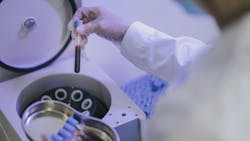What is platelet-rich fibrin (PRF) in dental surgery?
Introduction to platelet-rich fibrin
First developed in 2001, platelet-rich fibrin (PRF) is a biocompatible fibrin matrix that is easily extracted from a patient’s own blood. It contains platelet cytokines, growth factors, and cells that help speed the healing process for a variety of dental surgeries.1
Because it is produced from the patient’s own blood, and no additives are included, there is no risk of an allergic reaction.
Because it is much less complicated to use than the first-generation technology, platelet-rich plasma (PRP), its popularity has grown.
PRF can be made in any dental office with a centrifuge and venipuncture equipment, as long as the clinicians have the required training.
How PRF is created
To create PRF, the clinician must draw two small tubes of blood and place them in a centrifuge. The speed of the centrifuge and the time to spin the sample vary slightly depending on the desired result, but a common recommendation is to spin at 3,000 rpm for 10 minutes.1
The blood separates into three distinct layers: acellular platelet-deficient plasma (top), a PRF clot (middle) and red blood cells (bottom). The PRF plug is carefully separated from the other layers and delivered to the surgical site.2
Typically, the PRF plug is used immediately after creation, as its components begin to degrade rapidly. However, this is research ongoing to increase their shelf life.3 Advanced PRF (A-PRF) and injectable PRF (i-PRF) are new technologies focused on extending shelf life.
PRF contains, of course, platelets, but it also contains cytokines, adhesive proteins, and white blood cells (leukocytes) that secrete growth factors. These components work together to create a concentrated matrix that promotes the body’s own healing processes.4
A 2014 study found that altering the centrifuge protocol could change the clot’s specific cell types.5
Unlike PRP, PRF does not require bovine thrombin, making it a safer option for patients, and appealing to those looking for a “natural” option.
Benefits of PRF in dental surgery
Accelerates healing and enhances tissue regeneration: PRF uses the body’s own cells to create a concentrated dose of specialized cells to the treatment site. The PRF clot promotes new blood vessel formation.
Reduces postoperative discomfort: Because the healing process is greatly sped up with PRF, patients experience less pain and inflammation after surgery; the leukocytes and cytokines present in the matrix inhibit inflammation. These patients may require less pain relief, either from opioids or NSAIDs, all of which have undesirable side effects.
Minimizing risk of infection: The high levels of leukocytes and cytokines present in PRF also providing extra protection against postoperative infections, which could possibly require an antibiotic for treatment.
Applications of PRF in dental surgery
PRF is useful and beneficial for a wide variety of dental procedures, including:
Bone grafting: For patients who require bone grafts to have sufficient jawbone structure for implant placement, PRF can increase the quality and quantity of bone produced from the graft, as well as speed healing time. PRF helps support osteogenesis (bone formation) and can reduce the need for additional grafts. It has also been used to avoid damage to the gingival tissues during bone grafting.6
Localized alveolar osteitis: Also known as dry socket, this painful condition can develop after an extraction up to 20% of the time, and its incidence is even higher in some groups.2 PRF can be used to prevent this condition, increasing patient comfort and satisfaction.
Gingival regeneration: PRF has been used to successfully treat chemical burns from tooth whitening7, and for treatment of gingival recession.8 PRF has also been used for treatment of chronic periodontal defects, pocket reduction surgery, and guided tissue regeneration.
Endodontic surgery: PRF has been successfully used for revascularization of an immature necrotic tooth.9 Research is ongoing.
PRP vs. PRF: How do they compare?
Introduced in the late 1990s, PRP was a predecessor of PRF. While it offers some similar benefits, it is more complicated to prepare and requires the use of bovine thrombin and an anticoagulant, which can cause adverse effects. (Newer preparations may use autologous, or the patient’s own, thrombin, to reduce risks.) The equipment required is also more complex and costly, which limited its use to large surgery cases or hospitals.
Limitations and considerations of PRF use
Some studies have had conflicting results on the effectiveness of PRF, a 2024 review of the literature describes PRF as “an accepted minimally invasive technique with low risks and satisfactory clinical results.”1Further research will benefit the profession’s understanding.
Some disadvantages of PRF include:
- The technique is very sensitive to handling1
- Some patients may not want to have the necessary blood draw (although note the amount needed is quite small)1
- Some patients may not want or be able to afford the additional expense
- Very little is understood about its use in patients with coagulation and platelet disorders or who take blood clotting medications (e.g., heparin)11
Conclusion
Postoperative pain and discomfort are major reasons patients avoid dentistry, and can sometimes require management with opioids. PRF offers an innovative and low-risk way to speed healing and improve the patient experience, as well as the success rate of complicated and expensive procedures such as implants and bone grafts.
References
- Goswami P, Chaudhary V, Arya A, Verma R, Vijayakumar G, Bhavani M. Platelet-rich fibrin (PRF) and its application in dentistry: a literature review. J Pharm Bioallied Sci. 2024;16(Suppl 1):S5-S7. doi: 10.4103/jpbs.jpbs_435_23
- Stewart LR. Autologous platelet-rich fibrin: Use in prevention and treatment of dry socket. DentistryIQ. January 13, 2022. Accessed November 7, 2024. https://www.dentistryiq.com/dentistry/oral-maxillofacial-and-surgery/article/14223662/autologous-platelet-rich-fibrin-use-in-prevention-and-treatment-of-dry-socket
- Borie E, Oliví DG, Orsi IA, Garlet K, Weber B, Beltrán V, Fuentes R. Platelet-rich fibrin application in dentistry: a literature review. Int J Clin Exp Med. 2015;8(5):7922-9
- Grecu AF, Reclaru L, Ardelean LC, Nica O, Ciucă EM, Ciurea ME. Platelet-rich fibrin and its emerging therapeutic benefits for musculoskeletal injury treatment. Medicina (Kaunas). 2019;55(5):141. doi: 10.3390/medicina55050141
- Ghanaati S, Booms P, Orlowska A,et al. Advanced platelet-rich fibrin: a new concept for cell-based tissue engineering by means of inflammatory cells. J Oral Implantol. 2014;40(6):679-89. doi: 10.1563/aaid-joi-D-14-00138
- Goel A, Viaanueva JJ, Batra C, Satpathy B, Thompson T. Applications for platelet rich fibrin in dentistry. Decisions in Dentistry. April 8, 2021. Accessed November 7, 2024. https://decisionsindentistry.com/article/applications-platelet-rich-fibrin-dentistry/
- Petrescu BN, Mirica IC, Miron R, Campian RS, Lucaciu O. Platelet rich fibrin as a gingival tissue regeneration enhancer. J Dent Sci. 2021;16(1):536-539. doi: 10.1016/j.jds.2020.08.014.
- Rodas MAR, Paula BL, Pazmiño VFC, Lot Vieira FFDS, Junior JFS, Silveira EMV. Platelet-rich fibrin in coverage of gingival recession: a systematic review and meta-analysis. Eur J Dent. 2020;14(2):315-326. doi: 10.1055/s-0040-1701907
- Keswani D, Pandey RK. Revascularization of an immature tooth with a necrotic pulp using platelet-rich fibrin: a case report. Int Endod J. 2013;46:1096-1104.
- Rehan K. A quicker way to heal? PRP and PRF in dentistry. Ontario Academy of General Dentistry. April 20, 2020. https://www.agd.org/constituent/news/2020/04/20/a-quicker-way-to-heal-prp-and-prf-in-dentistry
- Hartshorne J, Gluckman H. A comprehensive clinical review of platelet-rich fibrin (PRF) and its role in promoting tissue healing and regeneration: part 2. Implant Practice US. https://implantpracticeus.com/ce-articles/a-comprehensive-clinical-review-of-platelet-rich-fibrin-prf-and-its-role-in-promoting-tissue-healing-and-regeneration-part-2/#Limitations
About the Author
Amelia Williamson DeStefano
Group Editorial Director
Amelia Williamson DeStefano, MA, is group editorial director of the Endeavor Business Media Dental Group, where she leads the publication of high-quality content that empowers oral-health professionals to advance patient well-being, succeed in business, and cultivate professional joy and fulfillment. She holds a master's in English Literature from the University of Tulsa and has worked in dental media since 2015.
Updated May 16, 2023



